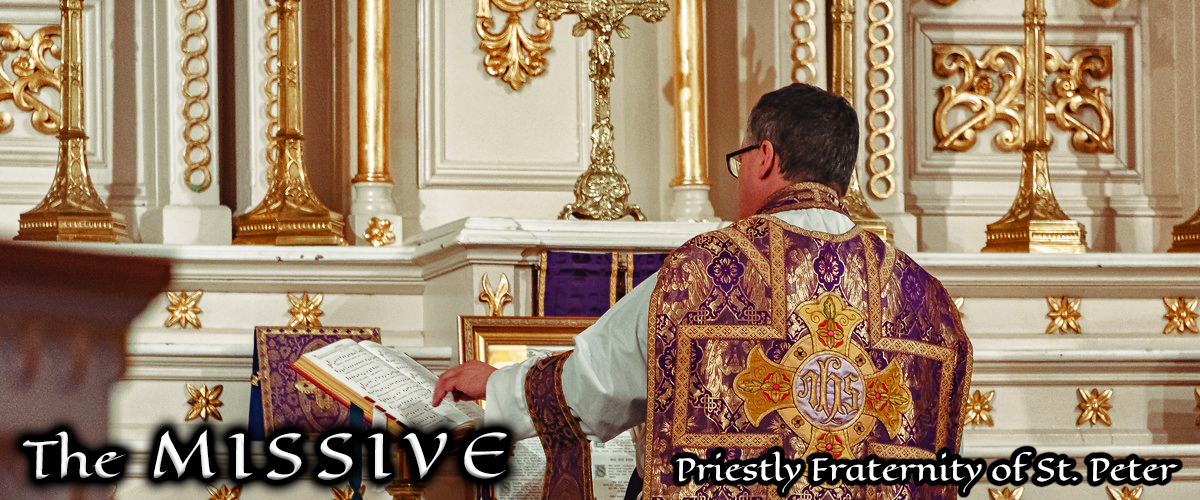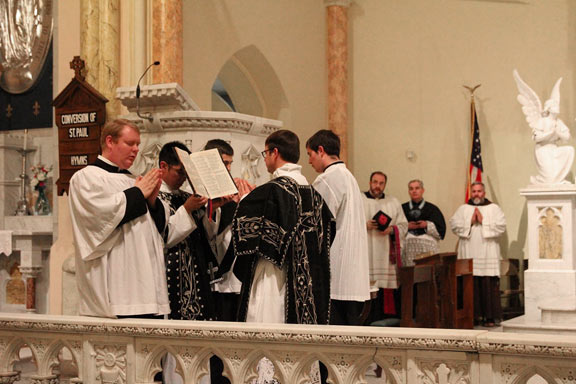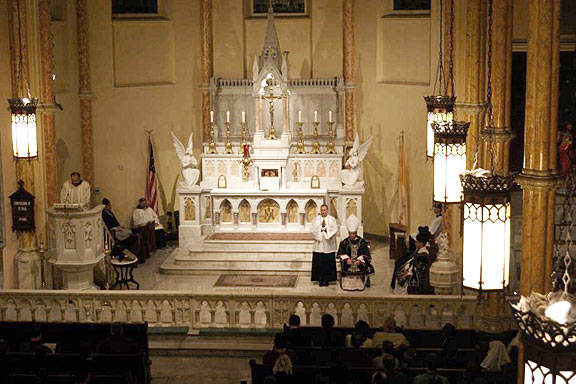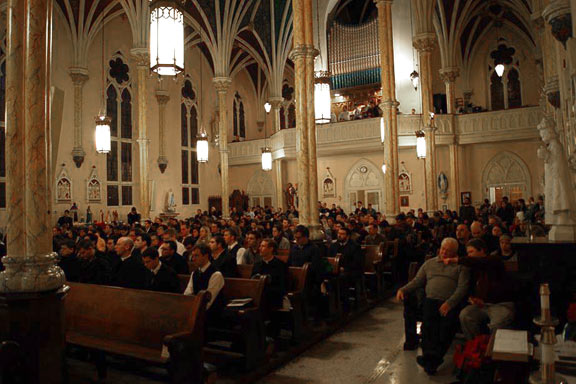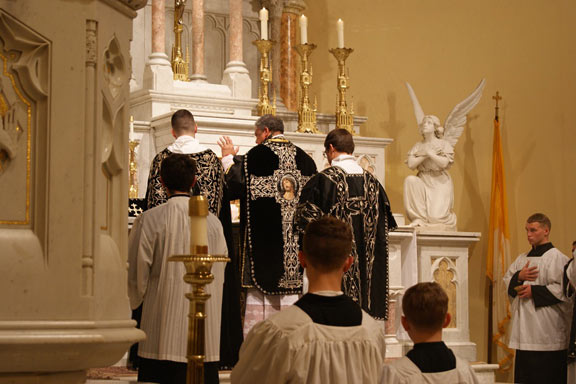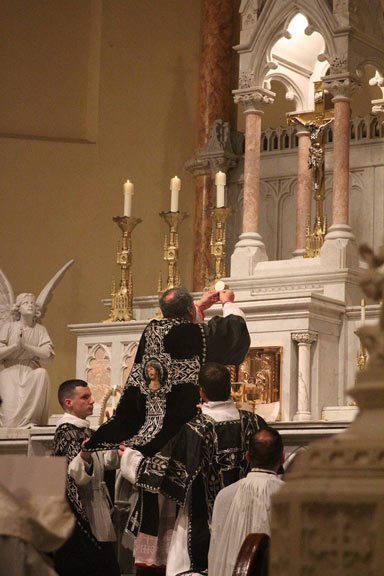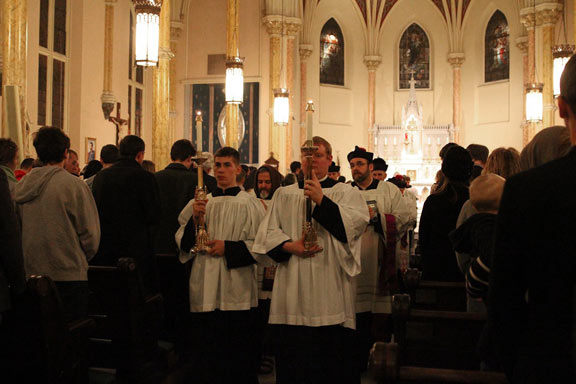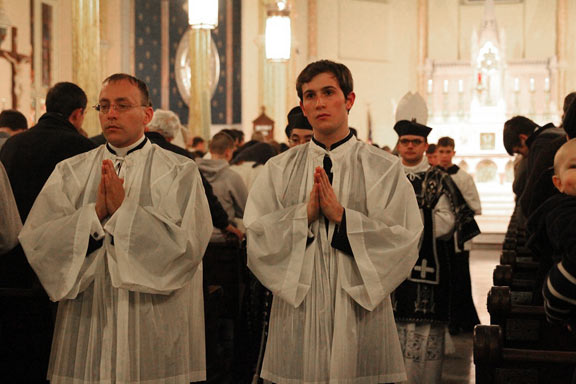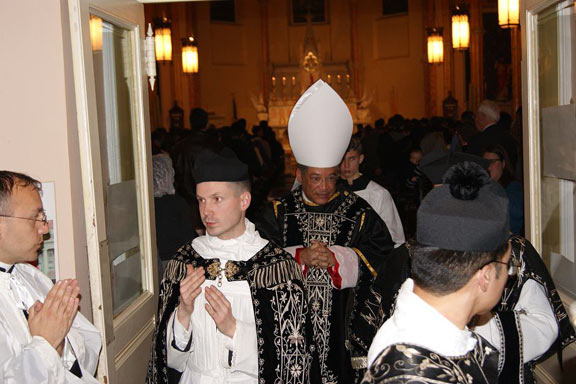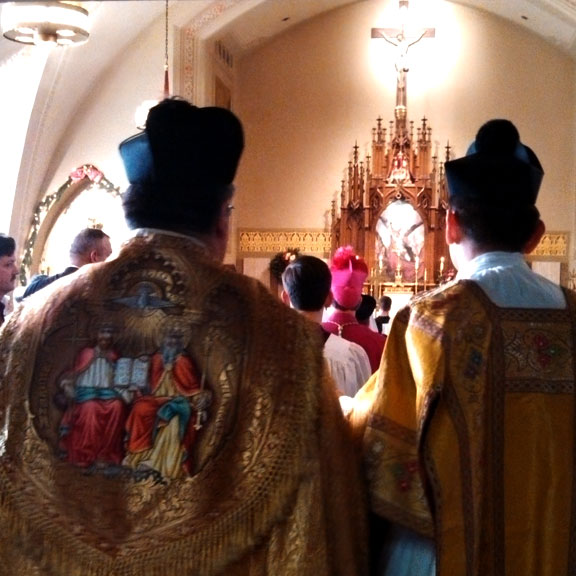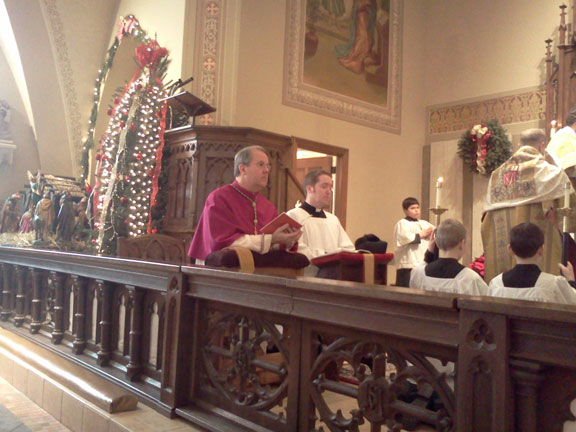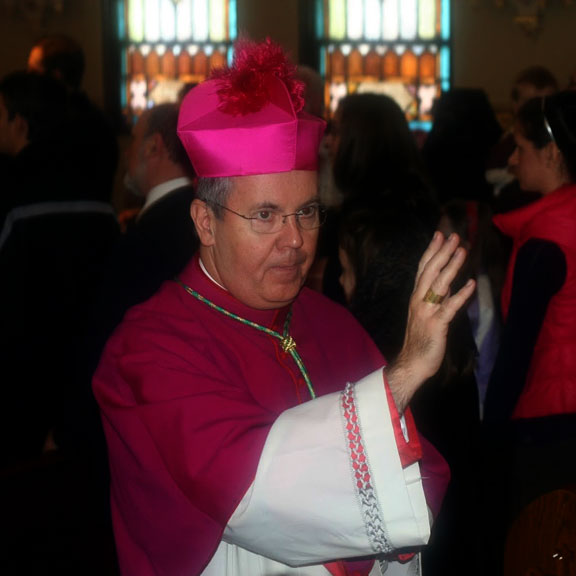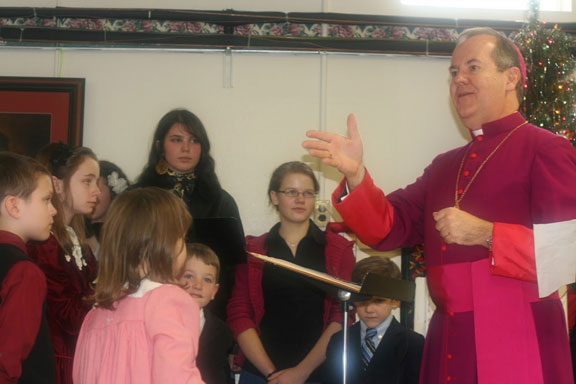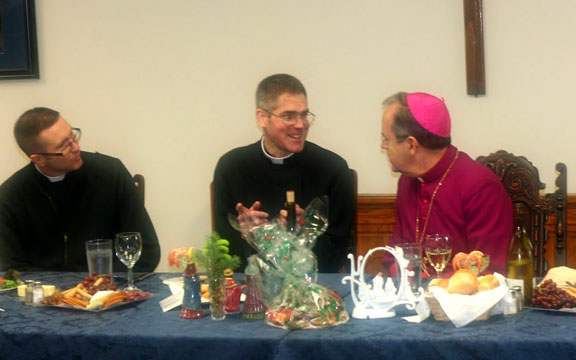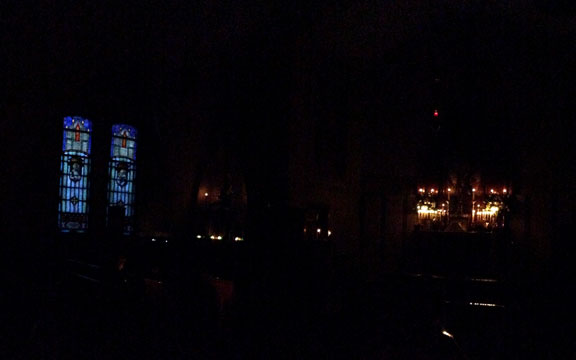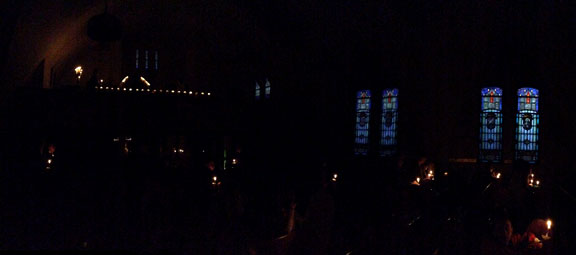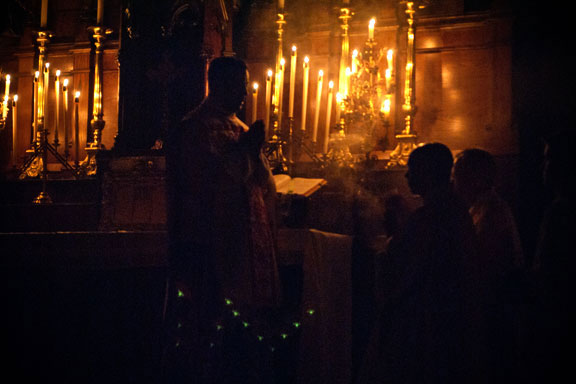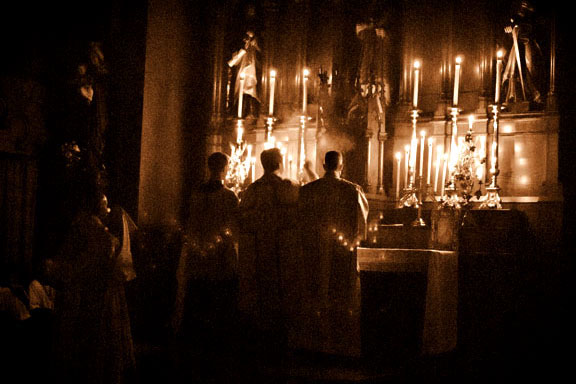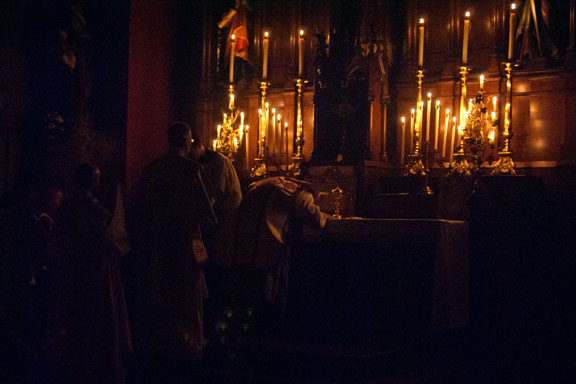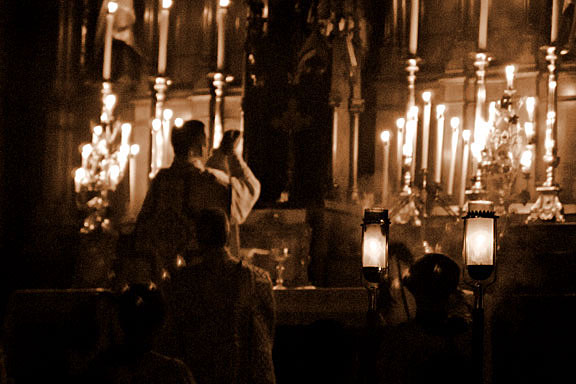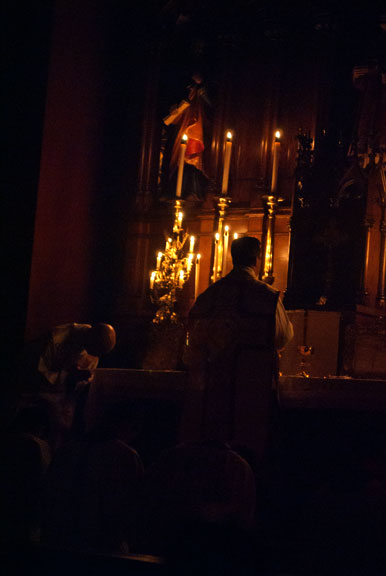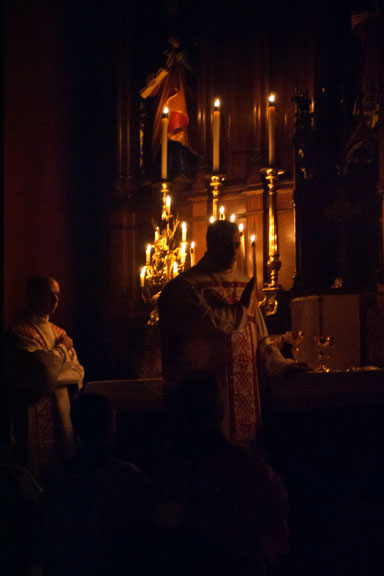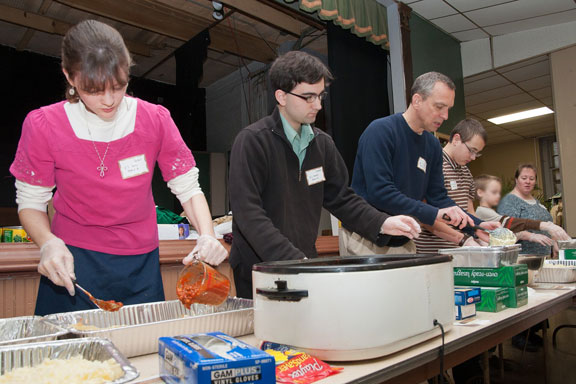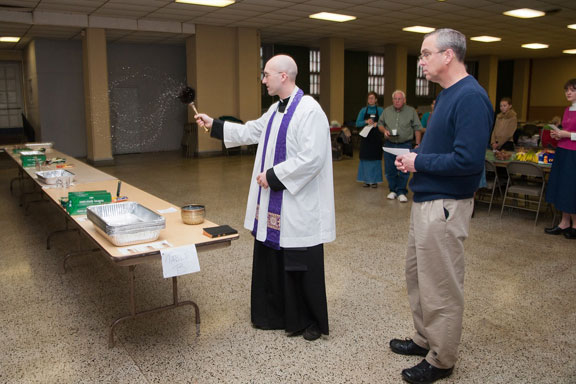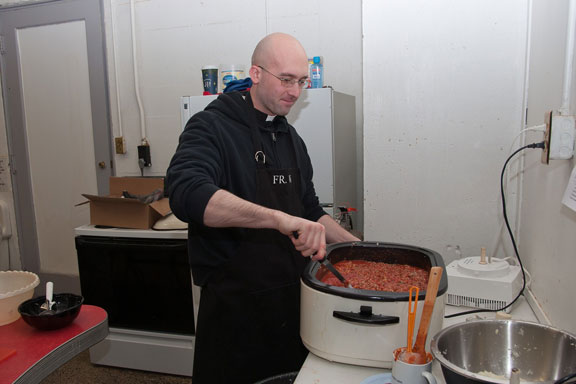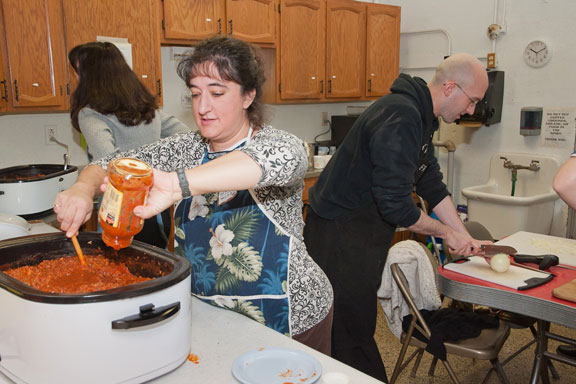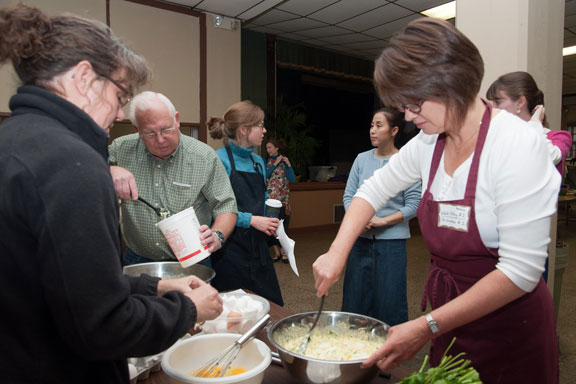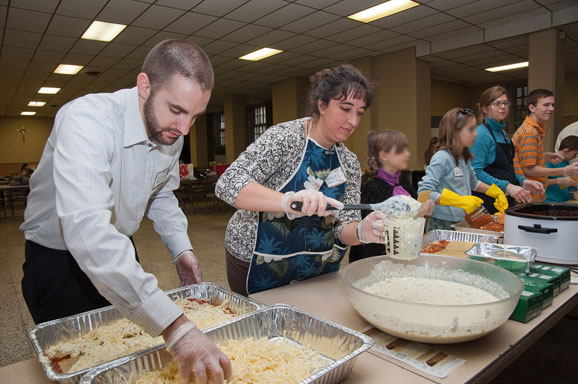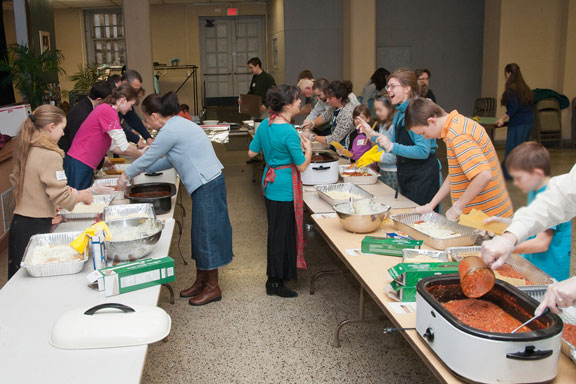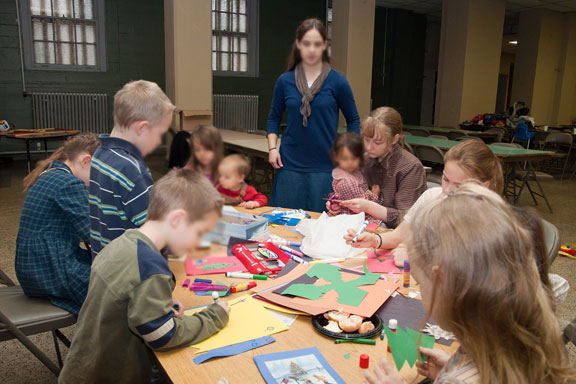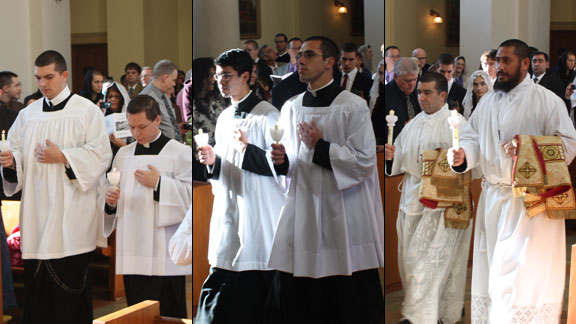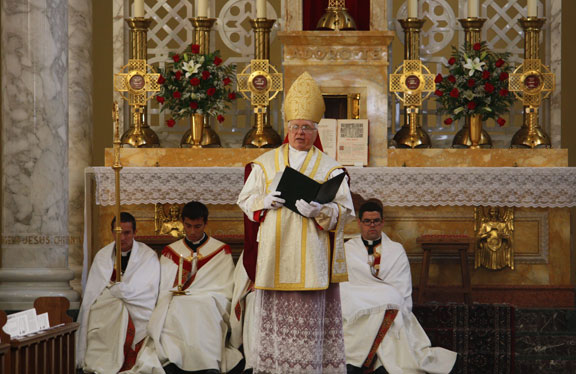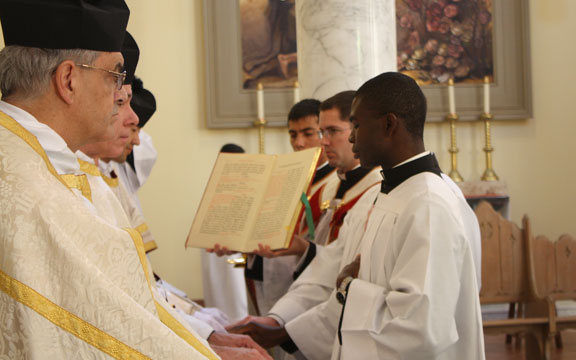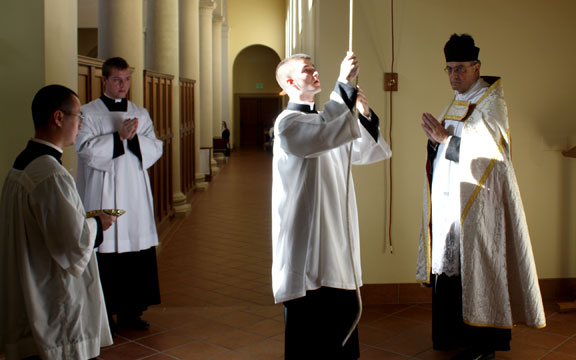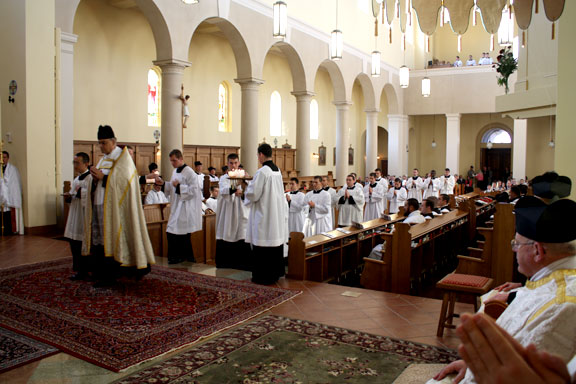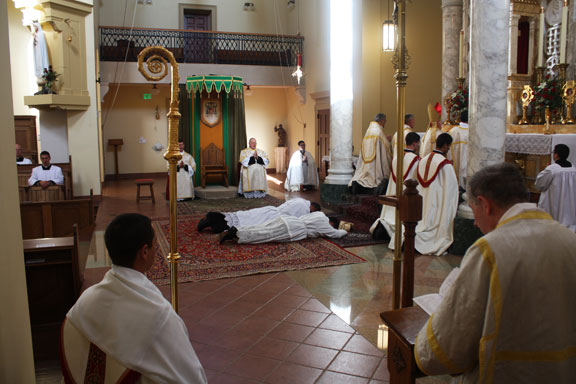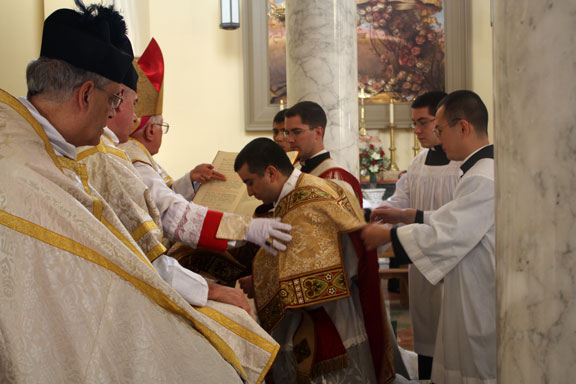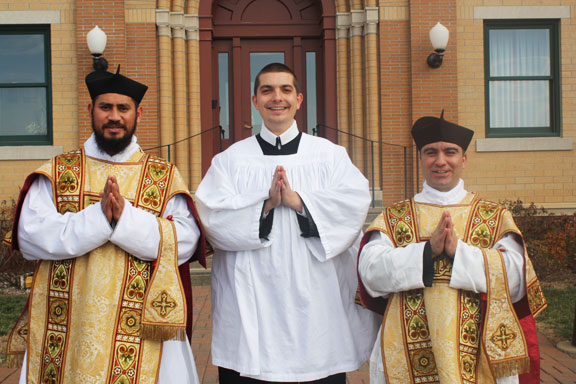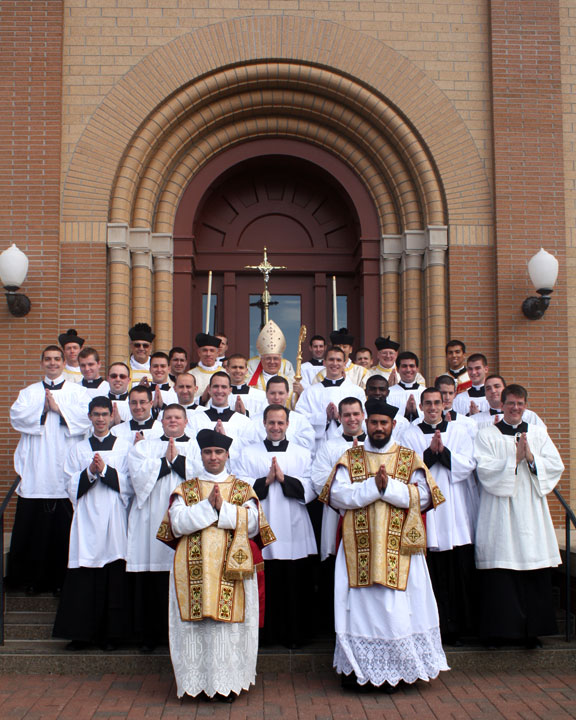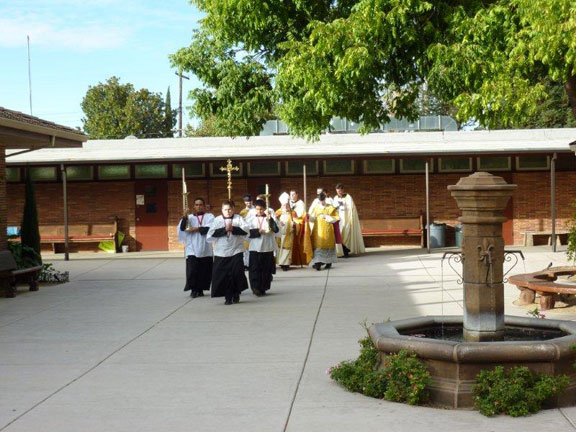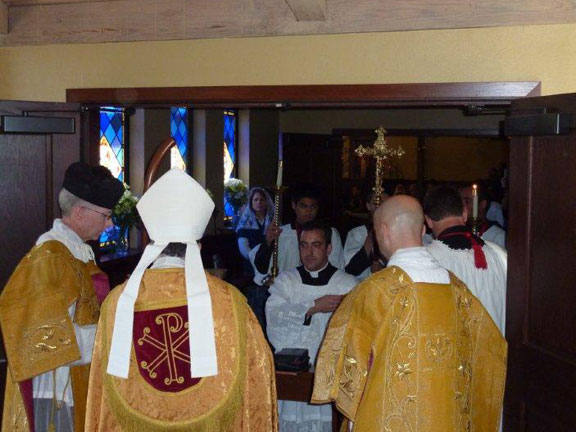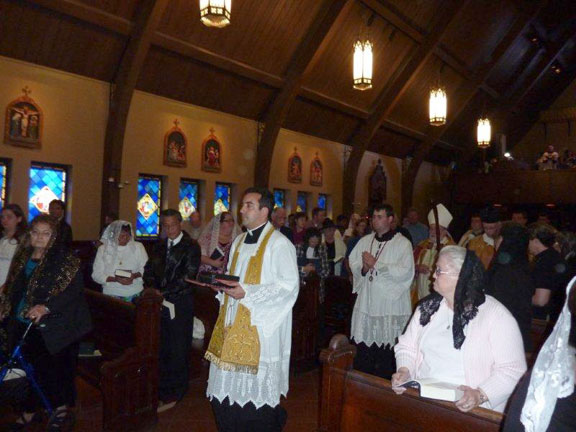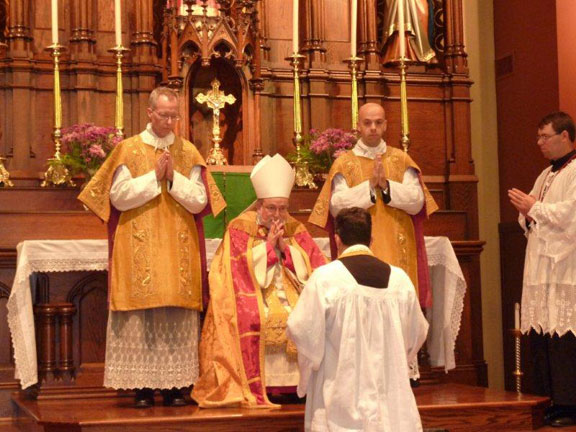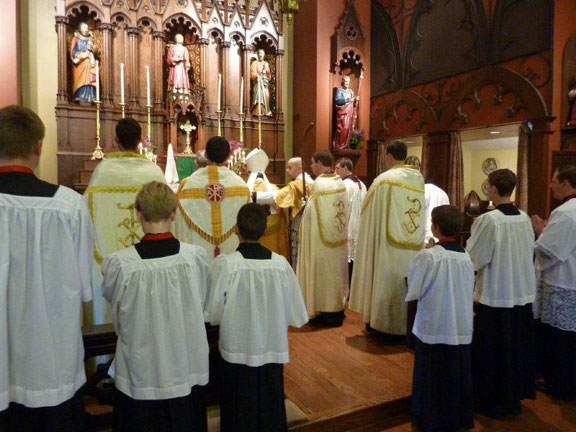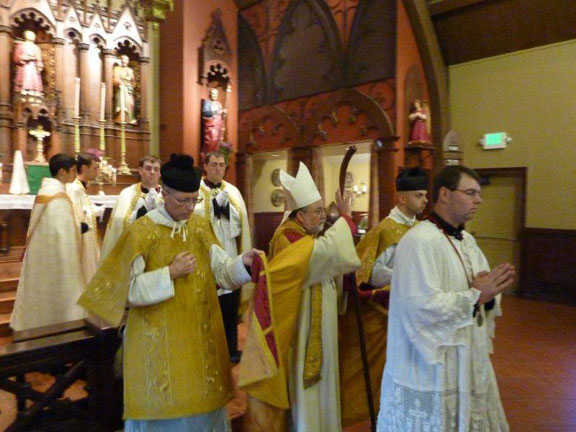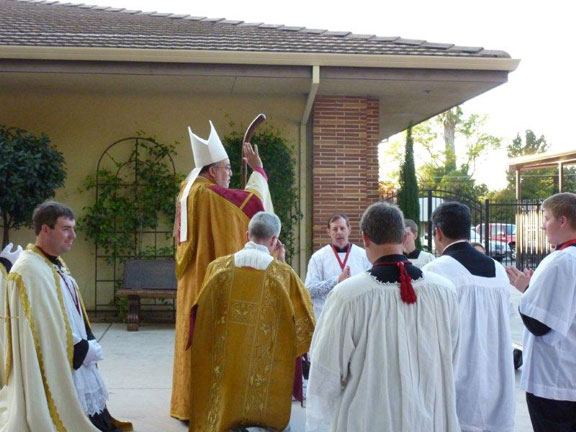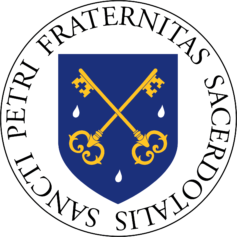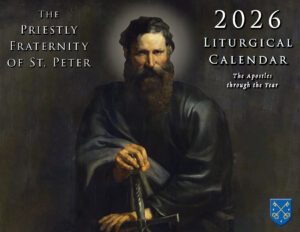March for Life 2013 Sees Two Traditional Masses at Old St. Mary’s in Washington DC
On January25th, the morning of the 2013 March for Life, the Traditional Latin Mass was offered by Fr. Gregory Pendergraft, FSSP, at St. Mary Mother of God (“Old St. Mary’s”) in Washington, D.C.
Father’s sermon focused on the interior conversion that each soul must experience, which drives them to act on behalf of their Faith. As it was the Feast of the Conversion of St. Paul, he referenced the change that overcame Saul, which caused him not only to stop persecuting the Christians, but also to devote his life to the preaching and teaching the Faith.
Father also utilized the story of Jonah, the minor prophet of the Old Testament who was told by God to preach repentance to the city of Nineveh. Rather than carry out the command of God, Jonah fled by ship, thus bringing punishment upon himself and his shipmates for refusing to carry out the Will of God. Father emphasized that we, like Jonah, will experience the tempests of misfortune in our lives and nation until we carry out the Will of God and live out our Faith in word and deed. Only then will our nation be converted and its citizens repent of the twin evils of abortion and contraception. We must eradicate these sins from our nation or they will destroy it completely, and this must be accomplished one soul at a time.
–
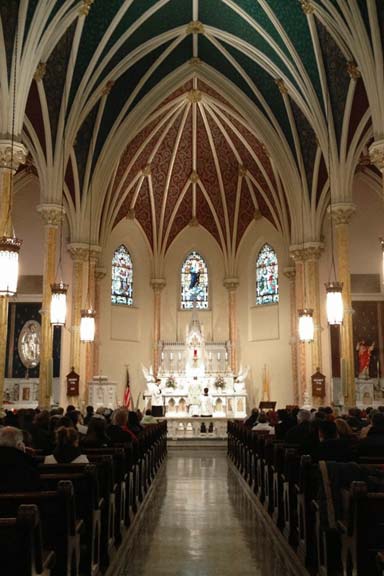
–
The Paulus Institute for the Propagation of Sacred Liturgy sponsored the Mass, which fell on the conversion of St. Paul, one of the feasts of their patron. The Mass was most appropriately offered in remembrance of and for the repose of the soul of Nellie Gray, the devoted leader of the March for Life. The propers were sung by St. Mary’s schola while the ordinary and motets were sung by a polyphonic choir.
–
In the evening after the March for Life, a Pontifical Mass at the faldstool was organized by the Priestly Fraternity of St. Peter and offered by the Most Reverend Joseph Perry, auxiliary bishop of Chicago.
Father Karl Marsolle, FSSP, was Deacon, Deacon Joseph DeGuzman, FSSP, was Subdeacon, and Fr. Beniot Guishard, FSSP, was the Assistant. Fr. Gregory Pendergraft, FSSP, was Master of Ceremonies. In addition, Msgr. Charles Pope of the Archdiocese of Washington lectored the readings in English and Fr. Alfred Harris, pastor of St. Mary’s, assisted at Mass. Msgr. Francis Nave and Canon Jean Marie Moreau were in choir.
The Fraternity offers many thanks to Fr. Harris for the use of St. Mary’s for both Masses, and to His Excellency Bishop Perry for offering the Holy Sacrifice of the Mass on such an important day in the pro-life movement.
–
January 22, 2013

On the Occasion of the Sixth Anniversary of the Foundation
Dear members of the Confraternity of Saint Peter,
Cordial greetings in our venerable Patron, the Apostle Saint Peter!
On Friday 22nd February, Feast of the Chair of Saint Peter, we will celebrate the sixth anniversary of the Confraternity’s foundation. On behalf of everyone, please allow me to express my heart-felt thanks for your spiritual commitment to and support of our priestly vocations and ministry.
You are doubtless aware of the fact that our young community will celebrate this year the twenty-fifth anniversary of its foundation. In the space of a quarter of a century, we have grown from the small group comprising a dozen founder members to roughly four-hundred, serving the souls of the faithful of one-hundred and sixteen dioceses spread across four continents. We work in the Lord’s vineyard as his humble and fallible servants, but made fecund by the strength of the Roman traditions of his Church and by the grace of hierarchical communion with the successors of his Apostles. However, do we not benefit from a third asset, less important than the first two, but essential for their concrete realisation? Indeed – your very selves. Each day, the 3800 souls of yours beg the Lord “to send labourers to his harvest,” as He commands us to do. Each day you recite, alone or with your family members, the beautiful Prayer of the Confraternity of Saint Peter, enhanced with quotations from our cherished Roman Missal. Wishing to be heard more speedily by the Lord, you request the intercession of His Blessed Mother, the Virgin Immaculate, by your daily recitation of a decade of the Holy Rosary. Finally, each year you arrange for the Holy Sacrifice of the Mass to be offered for the Confraternity’s intentions, thus providing for ten Masses to be celebrated each day for our priestly vocations and ministry.
All of us who have learned to “live by the faith” (Hebrews 10:38) know how your invisible prayers are a fundamental cause of the numerical and geographical expansion of our little Fraternity, and even more importantly of the supernatural good that the Lord deigns to bring about through its apostolic work. Without your commitment in daily prayer as members of the Confraternity of Saint Peter, we would not have the grace of admitting many candidates each year at our two international seminaries. Without your faithful prayers our priests would be less protected against the world enemy of Christ and of his Church, and less fervent in their sanctification for the glory of God and the salvation of souls. Allow me to share this in confidence. Like I do, surely my priest confrères ask themselves regularly how to improve our ministry. The hindrances to our priestly zeal are numerous: negative influence of the media, anti-natural laws voted by parliaments, lack of understanding of certain Churchmen in positions of responsibility, occasionally deficient time-tables and sacred edifices… Over the years however, the priest discerns more clearly the fundamental obstacle to his sacred ministry, which is his own lukewarmness. He laments his lack of mortification, of prayerfulness, of studiosity, of poverty, of purity, of obedience and of joyfulness. He understands more fully that the Lord Jesus wants to save the world through him and that only too often he does not love enough Jesus, the Church and the souls, that he is wasting the grace of his priesthood and rationing it out to souls.
Then it is, dear brethren, that the part you play is so important! Your prayer can obtain from the Lord an increase not only in the quantity but also in the quality of your priests and future priests. Satan said to the Curé of Ars: “Were there three like you in the world, my kingdom would be destroyed.” We are far more than three, and yet Jesus is still little known and poorly loved. Pray therefore dear friends and offer up sacrifices so that our seminarians will be docile and generous, and our priests faithful and supernatural. Fewer holy priests is better than many mediocre ones. Even better however is many, many, many eminently holy priests. And who will affirm that such is not God’s will! Dear friends, we also pray for you, for more holy married and single Catholics, for more holy young people, and for more holy clerics and consecrated persons within the Confraternity. You also pray for each other, even if you have not yet met all of the 3800 members of the Confraternity, you are present to them daily when they recite the Prayer, and at least each Sunday at Mass, and every month or more during Holy Hour. Let us thank God for this mutual support and let us offer up to Heaven more regular and more fervent prayers.
To that end, I shall inform you before Easter of an encouraging decision made by the Superiors of the Priestly Fraternity of Saint Peter. In the meantime, your Chaplains offer the Holy Sacrifice of the Mass for your intentions each month, and every 5th November the 236 priests of our Fraternity include your deceased members in the Memento of a Holy Mass of Requiem. Finally, I should like to remind you of the three plenary indulgences the Holy See granted you on the day of your incorporation and every year on 22nd February and 29th June.
With my best wishes in Saint Peter and Our Lady,
Fr Armand de Malleray, FSSP
General Chaplain of the Confraternity of Saint Peter

Bishop Bambera Makes Pastoral Visit to St. Michael for Epiphany
The priests and parishioners of Saint Michael Parish enjoyed a pastoral visit by the Bishop of Scranton, the Most Rev. Joseph Bambera, for the Feast of Epiphany on Sunday, January 6, 2013. Celebrating the Mass was Fr. Jose Zepeda, FSSP, Pastor, joined by Fr. Joseph Orlowski, FSSP, as Deacon, and Fr. Joseph Poisson, FSSP, as Subdeacon. In choir with the bishop was Fr. Brian Clark, in residence at the diocesan Cathedral of St. Peter.
The Feast of Epiphany, which means “manifestation,” is often referred to as Three Kings because the Gospel centers on the visitation of the wise men who visited Our Lord after following the Star of Bethlehem, falling down before Him in worship. Pious tradition holds that the kings were three in number, corresponding to the three gifts of gold, frankincense and myrrh that they offered to Him. Their names are held to be Balthasar of Arabia, Melchior of Persia, and Gaspar of India.
Once Mass concluded, His Excellency joined with parishioners and choir in singing the Angelus in honor of Our Lady. The annual Christmas dinner in the parish hall followed. Parishioners shared a grand feast while the choir and children’s Christmas choir sang hymns and other songs of the season.
After sharing company during the meal with the Mass celebrants, Fr. Flood, our District Superior, and other priests, His Excellency once again spoke to the parish, thanking the choir and reiterating his enjoyment of the Epiphany Mass and Christmas dinner. He commended the faithful for their commitment and faith, encouraging them to spread their faith, and make use of the gifts that God has given them.
January 17, 2013

Rorate Caeli Masses in Honor of Our Lady
The Rorate Caeli Mass is a traditional Advent devotion wherein the Mass of the Blessed Virgin Mary for Advent is offered just before dawn. In many instances families and individuals travel an hour or more, rising and arriving very early for this stunningly beautiful Mass. The interplay of light and darkness speak to the meaning of Advent and the coming of the Light of the world.
The Mass takes its title, Rorate Caeli, from the first words of the Introit, which are from Isaiah 45:8:
“Rorate, caeli, desuper, et nubes pluant justum, aperiatur terra, et germinet Salvatorem.”
“Drop down dew, ye heavens, from above, and let the clouds rain the just: let the earth be opened and bud forth a Saviour.”
The Rorate Mass is lit only by candlelight. Because it is a votive Mass in Mary’s honor, white vestments are worn instead of Advent violet. In the dimly lit setting, priests and faithful prepare to honor the Light of the world, Who is soon to be born, and offer praise to God for the gift of Our Lady. As the Mass proceeds and sunrise approaches, the church becomes progressively brighter, illumined by the sun as our Faith is illumined by Christ.
The readings and prayers of the Mass foretell the prophecy of the Virgin who would bear a Son called Emmanuel, and call on all to raise the gates of their hearts and their societies to let Christ the King enter; asking for the grace to receive eternal life by the merits of the Incarnation and saving Resurrection of Our Lord.
What follows are panoramic images from the Rorate Mass at St. Michael’s in Scranton, and images from the Rorate Mass celebrated by Fr. Matthew McNeely, FSSP, and the priests of St. Stephen the First Martyr in Sacramento.
January 8, 2013

A Corporal Work of Mercy: Holy Family in Dayton Helps Feed Over 425 Souls
The Fraternity parish of Holy Family in Dayton, Ohio, enjoyed the grace of caritas by performing a corporal work of mercy this past Advent season.
In mid-December, Fr. Mark Wojdelski, FSSP, the pastor of Holy Family, joined parishioners in creating twenty-three pans of lasagna. With a good dose of efficiency on the production line, the pans were created in a timely manner and then blessed by Father before delivery. The hearty food was able to feed nearly 450 souls in the Dayton area through the Saint Vincent de Paul Society.
It is edifying to see corporal works of mercy, since they are both commanded and rewarded by God. As Our Lord admonished us in the strongest of terms:
And when the Son of man shall come in his majesty, and all the angels with him, then shall he sit upon the seat of his majesty. And all nations shall be gathered together before him, and he shall separate them one from another, as the shepherd separateth the sheep from the goats: And he shall set the sheep on his right hand, but the goats on his left.
Then shall the king say to them that shall be on his right hand: Come, ye blessed of my Father, possess you the kingdom prepared for you from the foundation of the world. For I was hungry, and you gave me to eat; I was thirsty, and you gave me to drink; I was a stranger, and you took me in; Naked, and you covered me: sick, and you visited me: I was in prison, and you came to me.
Then shall the just answer him, saying: Lord, when did we see thee hungry, and fed thee; thirsty, and gave thee drink? And when did we see thee a stranger, and took thee in? or naked, and covered thee? Or when did we see thee sick or in prison, and came to thee? And the king answering, shall say to them: Amen I say to you, as long as you did it to one of these my least brethren, you did it to me.
Then he shall say to them also that shall be on his left hand: Depart from me, you cursed, into everlasting fire which was prepared for the devil and his angels. For I was hungry, and you gave me not to eat: I was thirsty, and you gave me not to drink. I was a stranger, and you took me not in: naked, and you covered me not: sick and in prison, and you did not visit me.
Then they also shall answer him, saying: Lord, when did we see thee hungry, or thirsty, or a stranger, or naked, or sick, or in prison, and did not minister to thee? Then he shall answer them, saying: Amen I say to you, as long as you did it not to one of these least, neither did you do it to me. And these shall go into everlasting punishment: but the just, into life everlasting.
~ Matthew 25:31-46
December 28, 2012

Our Lady of Guadalupe Seminarians Receive Minor Orders and Subdiaconate
His Excellency Fabian Bruskewitz, Bishop Emeritus of the Diocese of Lincoln, made his return to Our Lady of Guadalupe on Saturday, November 17, 2012 in order to convey both Minor Orders and the Subdiaconate upon seminarians.
The Minor Order of Lector was administered upon 16 seminarians, the Minor Order of Exorcist and Acolyte on five seminarians, and two seminarians were raised to the Subdiaconate.
Of the twenty-three men who received orders, three are members of the Congregation of the Sons of the Most Holy Redeemer, or Transalpine Redemptorists. When they are not studying at Our Lady of Guadalupe, they reside at Golgotha Monastery Island, Papa Stronsay, in the Orkney Islands of Scotland.
The Fraternity of Saint Peter again gives its most sincere thanks to Bishop Bruskewitz for his many years of support and guidance, his conferral of innumerable Orders upon the Fraternity members, and his kind and gracious support in establishing our seminary within the diocese of Lincoln. In your kindness, please keep our ordinands and those of the Transalpine Redemptorists in your prayers, as they continue their journey towards the Priesthood of Our Lord.
More pictures and information of the ordinations can be found in the Fraternity Newsletter. Not a subscriber? Request your newsletter here.
November 21, 2012

St. Clement Parish in Ottawa Finds a New Home
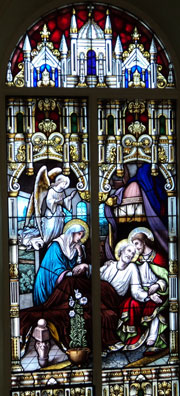
by Fr. Garrick Huang, FSSP
Assistant Pastor, St. Clement Parish
Not the least among all the works of charity that we Catholics are called by Christ to perform is that of restoring sacred places to their intended order and beauty. Christ told Saint Francis: “Rebuild my Church”, and so Francis set about replacing the stones of an old fallen-down chapel. He didn’t yet realize that Christ had put a capital letter ‘C’ on the word ‘Church’. It would seem that we parishioners of Saint Clement have been called to a similar task.
Archbishop Prendergast must have in mind a greater calling for the Saint Clement congregation, for we serve the entire diocese in providing the sacraments and celebrating Mass according to the liturgical books of 1962, as intended by popes John Paul II and Benedict XVI; “…for those faithful attached to the traditional rites.” Geographically, our congregation is spread over the whole diocese. It is not unusual for our parishioners to travel an hour or more to attend Sunday or even daily Mass.
Even though our home at Saint Clement Church, built in 1955, was well maintained over the years, it became apparent that there were some fundamental physical repairs and changes needed if we planned to remain. In the meantime, the nearby heritage church dedicated to Saint Anne became available.
Saint Anne Church was built in 1873, then soon expanded and modified to serve the French Canadians of Lowertown Ottawa. Owing to urban renewal in the 1960s, most all the local families were forced to quit the homes that had formed the parish during the last century. In 2011, with regret, the St. Anne parish councils petitioned the Archbishop to close their Church, a difficult and agonizing decision after so many years of service to parishioners and the local community.
At the suggestion of the Archbishop, our parish accepted the offer to relocate to St. Anne and, after much deliberation, we began life in our new home on Trinity Sunday in 2012. We retain our name St. Clement Parish, but now have two patrons: St. Clement and St. Anne, to whom the Church remains dedicated.
Archbishop Prendergast visited us, as a father to his family, on the feast of the Assumption, August 15th. In his sermon, after acknowledging the challenges before us, he reminded us that this is the oldest feast of Mary; that it was originally called the ‘Dormition’ in the East and West of Christendom, and that pope Pius XII proclaimed the Assumption of Mary a dogma of the Catholic Church in the Apostolic Constitution Munificentissimus Deus in 1950.
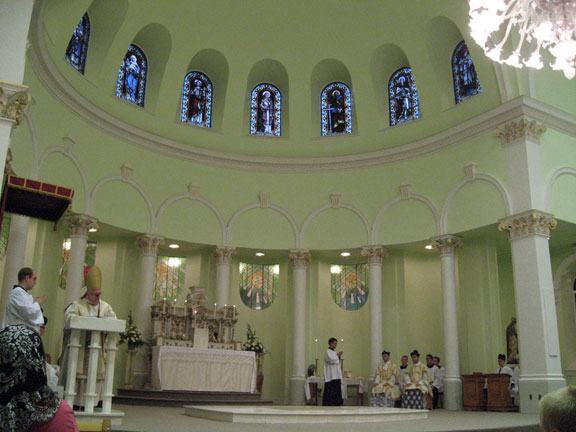
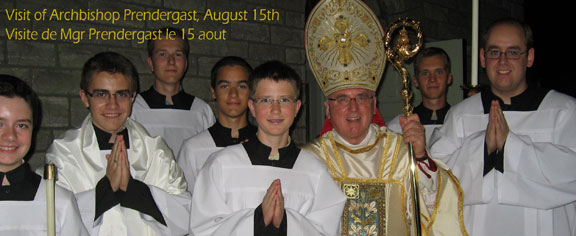
We have begun work on some of the foundations before winter sets in. Temporary modifications to the sanctuary have been made while we work out a long-term concept for the interior. We have been graciously assisted in this task by a curator of the National Art Gallery, a specialist in pre-Confederation French-Canadian architecture, altars and sacred vessels.
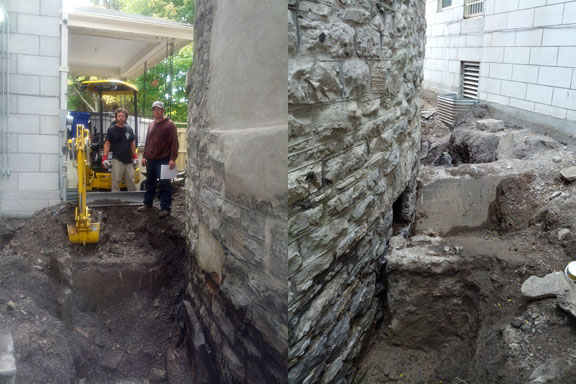
The move has brought new parishioners and a renewed dedication of old ones as we move forward with plans for the restoration of this heritage building, the construction of a parish hall, the renewal of the church interior in conformity with our liturgical life, and the growth of this community that has, since 1968, kept alive the great liturgical traditions of the Church.
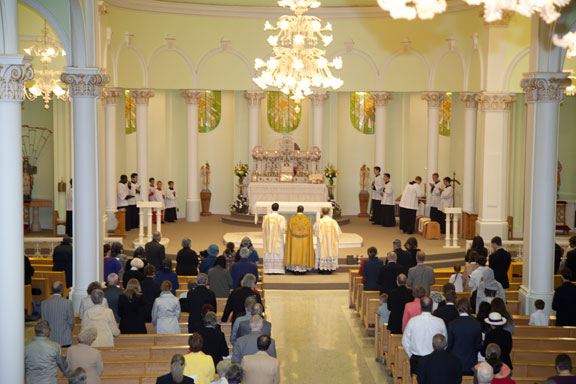
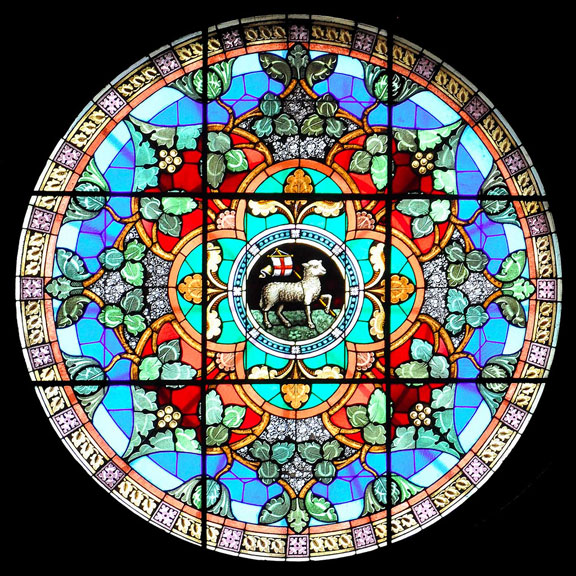
November 20, 2012

Fr. Matthew McNeely, FSSP, Installed as Pastor of St. Stephen in Sacramento
The Most Reverend Jaime Soto, Bishop of Sacramento, appointed Fr. Matthew McNeely, FSSP, as pastor of the Fraternity’s Sacramento apostolate, St. Stephen the First Martyr, in September of 2012. On October 21, 2012 he made a pastoral visit to St. Stephen in order to formally install Father McNeely as the pastor.
The installation of Fr. McNeely crowned Father’s long history of priestly care offered to the traditional Catholic faithful in Sacramento, dating back to his assignment to the parish, while still a deacon, in June of 2006. After his priestly Ordination in 2007, Fr. McNeely was assigned to St. Stephen as the parish administrator in November of 2008, and has now received full canonical authority as the pastor. Many thanks to Bishop Soto for this appointment and his pastoral visit.
November 15, 2012

Bishop Bruskewitz Conveys Tonsure to 18 Seminarians
With great gladness and joy, the Fraternity of Saint Peter is pleased to have the largest class of tonsurandi in the history of the North American District. Most Rev. Fabian Bruskewitz, Bishop of Lincoln, traveled to Our Lady of Guadalupe Seminary on Saturday, October 20, 2012, to administer the Rite of Tonsure upon 18 seminarians.
The Rite of Tonsure is administered early in the second year of formation, and is the point at which a seminarian ends life in civilian clothes and is invested with the cassock and surplice. The 1911 Catholic Encyclopedia gives an excellent overview of the rite:
(From the Latin verb tondere, “to shear.”)
A sacred rite instituted by the Church by which a baptized and confirmed Christian is received into the clerical order by the shearing of his hair and the investment with the surplice. The person thus tonsured becomes a partaker of the common privileges and obligations of the clerical state and is prepared for the reception of orders. The tonsure itself is not an ordination properly so called, nor a true order. It is rather a simple ascription of a person to the Divine service in such things as are common to all clerics. Historically the tonsure was not in use in the primitive Church during the age of persecution. Even later, St. Jerome (in Ezech., xliv) disapproves of clerics shaving their heads. Indeed, among the Greeks and Romans such a custom was a badge of slavery. On this very account, the shaving of the head was adopted by the monks. Towards the end of the fifth, or beginning of the sixth, century, the custom passed over to the secular clergy.
As a sacred rite, the tonsure was originally joined to the first ordination received, as in the Greek Church it still is to the order of lector. In the Latin Church it began as a separate ceremony about the end of the seventh century, when parents offered their young sons to the service of God. Tonsure is to be given by a candidate’s ordinary, though mitred abbots can bestow it on their own subjects. No special age for its reception is prescribed, but the recipient must have learnt the rudiments of the Faith and be able to read and write. The ceremony may be performed at any time or place. … According to canon law, all clerics are bound to wear the tonsure under certain penalties. But on this subject, Taunton (loc. cit. inf.) says: “In English-speaking countries, from a custom arising in the days of persecution and having a prescription of over three centuries, the shaving of the head, the priestly crown, seems, with the tacit consent of the Holy See, to have passed out of use. No provincial or national council has ordered it, even when treating of clerical dress; and the Holy See has not inserted the law when correcting the decrees of those councils.”
Many thanks to Bishop Bruskewitz for his tireless support of the Fraternity of Saint Peter. Expanded coverage and pictures will be in the next Fraternity Newsletter. If you do not receive the newsletter, please sign up today.
In your kindness, please pray for our new tonsured seminarians, and for all of our postulants, seminarians, sub-deacons, deacons, and priests.
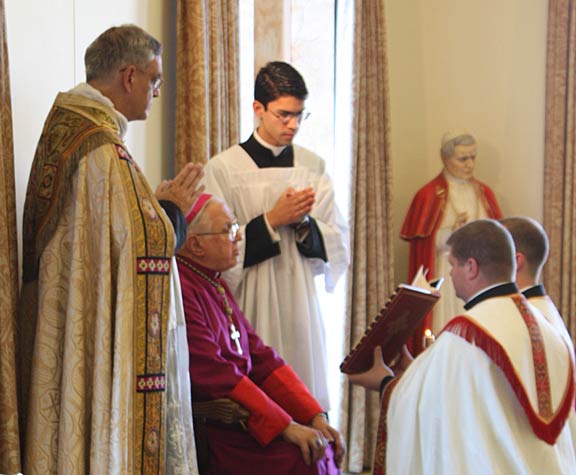
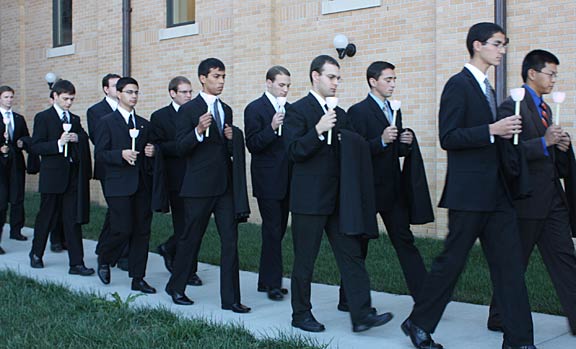


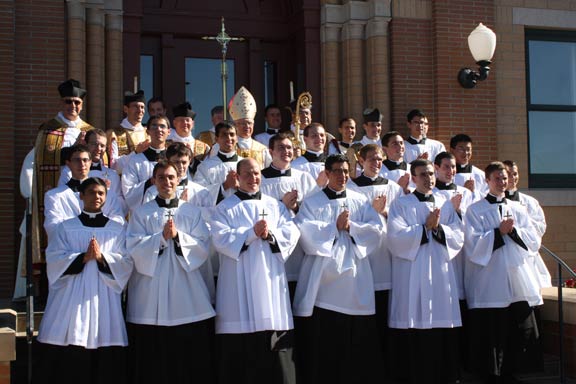
November 12, 2012

Fr. Gregory Pendergraft, FSSP, Speaks at the Catholic Identity Conference in Weirton, WV, Sept 28-30, 2012
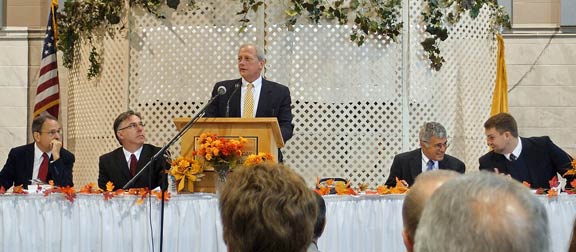
A wide variety of Catholic faithful gathered together in Weirton, WV, for the 2012 Catholic Identity Conference from September 28-30, 2012, including our own Fr. Gregory Pendergraft, FSSP. Saturday began with Fr. Pendergraft offering the Holy Sacrifice of the Mass at St. Joseph the Worker Catholic Church.
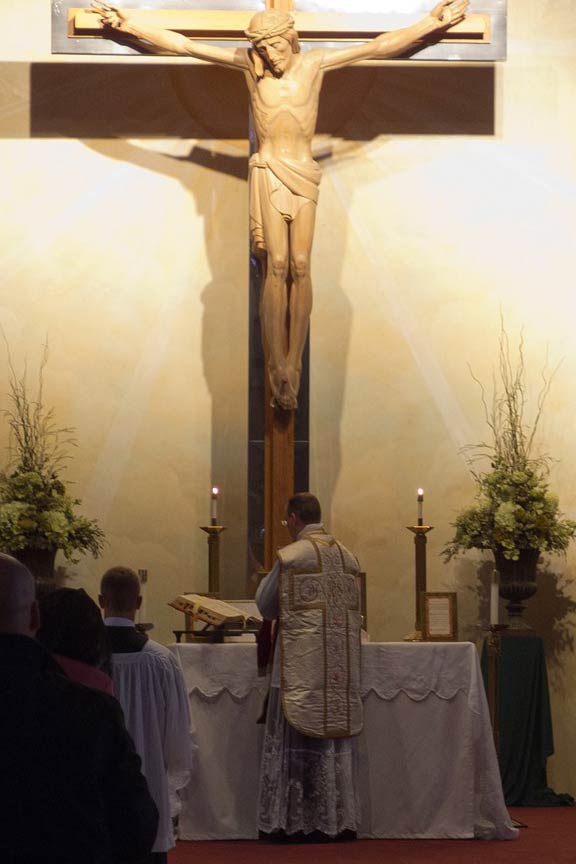
Later in the morning, Mr. Michael Matt began the conference with “Faith, Family, and Freedom;” a talk on the threats to the Catholic Faith in the modern secular world. He spoke of the advances of the Traditional Latin Mass throughout the world and the growing anti-Christian voices attempting to silence Our Lord in this world.
Mr. John Vennari spoke on the six components of Liberal Catholicism as outlined by Msgr. Fenton in 1958, who explained the aims of liberalism well before the Second Vatican Council was called. It was Msgr. Fenton’s contention that liberalism in the Church has become so widespread that it is pervasive and almost invisible. Mr. Vennari stated that Msgr. Fenton’s prophetic warning about liberalism in the Church was necessary because Blessed Pius IX had warned that such liberalism would lead to the ruin of religion and prevent us from meriting the blessings of God. Mr. Vennari also spoke on the Church’s relationship to Judaism and the practical problems that can occur with interfaith dialogue.
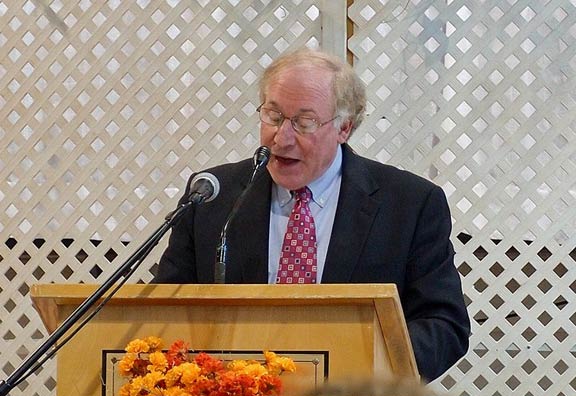
Mr. Christopher Ferrara’s talk was entitled “Flatland,” and spoke of the modern nation-state that sees human beings only as voters and workers or consumers, and ignores the primary focus of the moral life, which is intrinsic to man. Mr. Ferrara explained this two-dimensional approach ends up in the atomization of society, wherein the citizen ultimately answers only to the state and leaves behind the rich social complexity that was Christendom. Mr. Ferrara explained that we have the key to free ourselves from this hideous flatland, if only we would use it.
Dr. John Rao next discussed precedents in history when there was great crisis in the Church, where there would be a small group of Catholics relatively unknown, perhaps even to each other, who would be the beginning of a great restoration. During such periods, there is often confusion between what is genuine Tradition, and what has become mere (and perhaps corrupt) custom that is mistaken for Tradition. When those fighting to restore genuine Tradition begin to make their presence felt, they are often resisted by those who have become attached to mere custom.
Mr. James Vogel concluded the afternoon presentations with an overview of the life of Archbishop Marcel Lefebvre and the history of the Society of Saint Pius X through the present time, including what role the SSPX serves in the Church today.
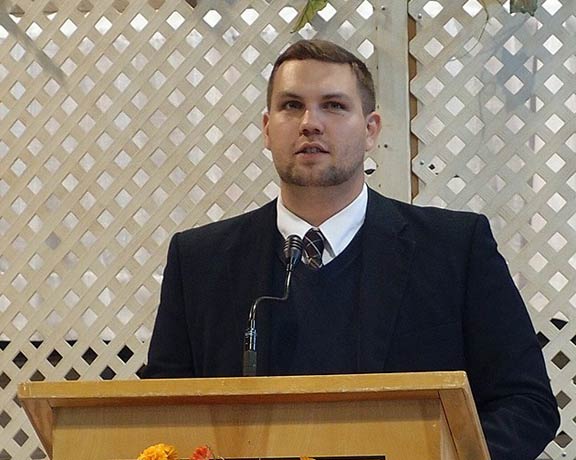
The conference ended with dinner on Saturday evening, whereafter which our Fr. Pendergraft gave a presentation that called for an ever-increasing fidelity to the Faith and an increase of prayer and sacrifice. His talk centered around Blessed Jacinta of Fatima as an example of heroic sacrifice.
Participants completed their weekend on Sunday morning with a Missa Cantata, once again offered by Fr. Pendergraft, at Sacred Heart of Mary Catholic Church, in Weirton. Father Pendergraft’s and the other participants’ talks can be purchased from Catholic Identity 2012, on CD.
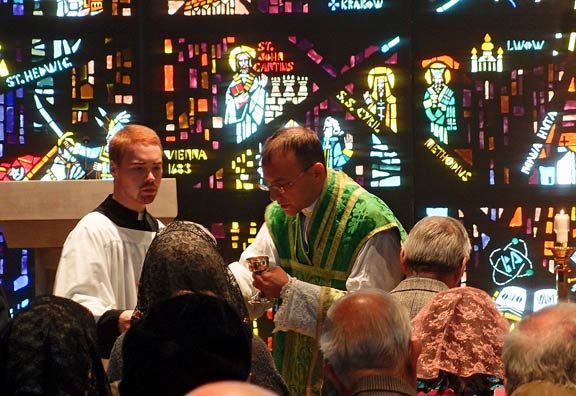
November 1, 2012

